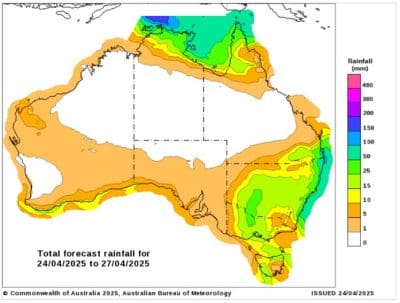
Seeding is well underway at Lawson Grain’s Borambil site in southern NSW. Photo: Lawson Grains
AFTER THE Easter break delivered little of the rainfall needed to bolster planting confidence across southern New South Wales, western Victoria and South Australia, growers are once again pinning hopes on showers forecast for the weekend.
Persistent dry conditions across Australia’s southern states continue to shape domestic markets, as global markets remain subdued in the wake of last week’s sharp currency shifts.
The Liverpool Plains is a week or two from finishing a bumper sorghum harvest, with domestic buyers confident in securing required volumes, easing market competition.
Dry sowing of canola is ongoing in parts of the country, with wheat planting expected to ramp up next week.
| Apr 17 | Today | |
| Barley Downs | $335 | $335 |
| ASW Downs | $355 | $355 |
| Sorghum Downs | $365 | $360 |
| Barley Melbourne | $360 | $360 |
| ASW Melbourne | $375 | $370 |
Table 1: Indicative prices in Australian dollars per tonne.
Dollar, quality continues to impact sorghum
The Australian dollar has remained relatively stable over the past week at around US64 cents.
However, the shock of it slipping to just under 60c from April 6-10 and rallying 4c soon after has continued to limit export interest in sorghum.
This, combined with quality concerns in later-harvested crops across the Liverpool Plains and Darling Downs, has seen prices ease slightly.
Armidale-based Delta Grain Marketing general manager Mick Parry said in particular the colour deterioration was impacting pricing.
“In the Border regions, Darling Downs and Northern NSW the later sorghum…has had 150-200mm of rain on it so the colour has deteriorated,” Mr Parry said.
“That is the most important thing for the baijiu market.”
He said along with shorter harvest days, there was an increase in Sorghum 2 and Sorghum X on the market.
Mr Parry said that while such conditions can push prices either way, in this case, the decline in quality was “putting some downward pressure on the price”.
The Liverpool Plains is also forecast to receive 10-15mm over the weekend, which could further delay the end of harvest and exacerbate the quality concerns.
AgVantage Commodities broker at Narrabri, Brendon Warnock, said the upcoming culmination of harvest was coinciding with a slight drop in enthusiasm from buyers.
However, he noted that despite this, “prices have held up okay”.
“The season is progressing and a lot more of the buyers are securing the tonnes that they need or are more comfortable about securing the tonnes that they need,” Mr Warnock said.
“We aren’t seeing the same level of competition.”
Selling remains thin in south
It’s Groundhog Day in the south, as persistent dry conditions continue to dampen grower selling and prompt domestic buyers to secure short-term cover.
Despite widespread Easter rain of 5-15mm in southern cropping regions, confidence remains low as winter crop planting gathers pace in the weeks ahead.
The Bureau of Meteorology is again forecasting decent rainfall for much of Victoria, New South Wales and southeast Queensland in the coming days of up to 50mm.
South Australia is likely to miss the approaching front, though some isolated areas may still receive a few millimetres of rain.
“The main sentiment is that if it remains dry in certain areas, the market will continue to appreciate,” Mr Noonan said.
“We’ve got another change this weekend; we’ll wait to see what happens and believe it when we see it in the rain gauge.”
He said growers were continuing to dry sow canola and pulses with some wheat crops being planted.
“Wheat will start up in a bigger, larger way next week and then they’ll get into barley.”

The lack of immediate rainfall is limiting grower selling, with a “definite lack of liquidity in the market” as a result.
Mr Noonan said domestic buyers were continuing to “chip away” at buying and that “they have the nearby sorted, the next month or two to a fair degree”.
He said they were starting to look at covering from July onwards.
“In general, [they’re] covered in the short term mostly; in the medium to long term, they’re probably still exposed but happy to roll on see what happens.”
The lack of decent weekend rain had driven increased interest in barley from southern NSW graziers, according to Mr Parry.
“The southern NSW area missed forecast rain in the Easter break.
“So after the Easter break, we fielded a number of calls from graziers wanting to buy barley.
It’s soo dry down there, even if they get rain…they will be feeding stock through the winter.”
While many domestic consumers in the southern states are currently meeting demand with local stocks, the buying arc is expected to extend further north if meaningful rainfall doesn’t arrive soon.
“The buying arc for barley buyers is just going to creep north through the central west.
“More and more barley will be heading south from the central west, it is already, but that drawing arch will drift further north as they run out of easy stock ex-farm.”
Grain Central: Get our free news straight to your inbox – Click here

HAVE YOUR SAY